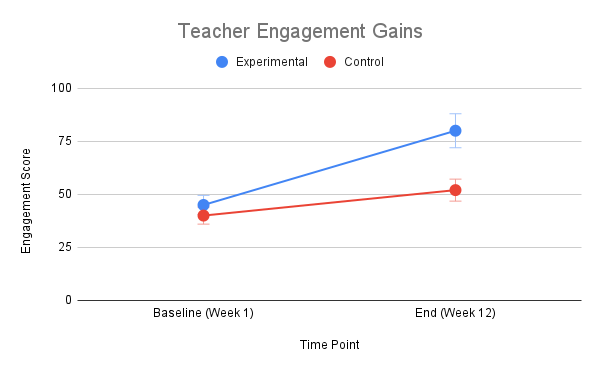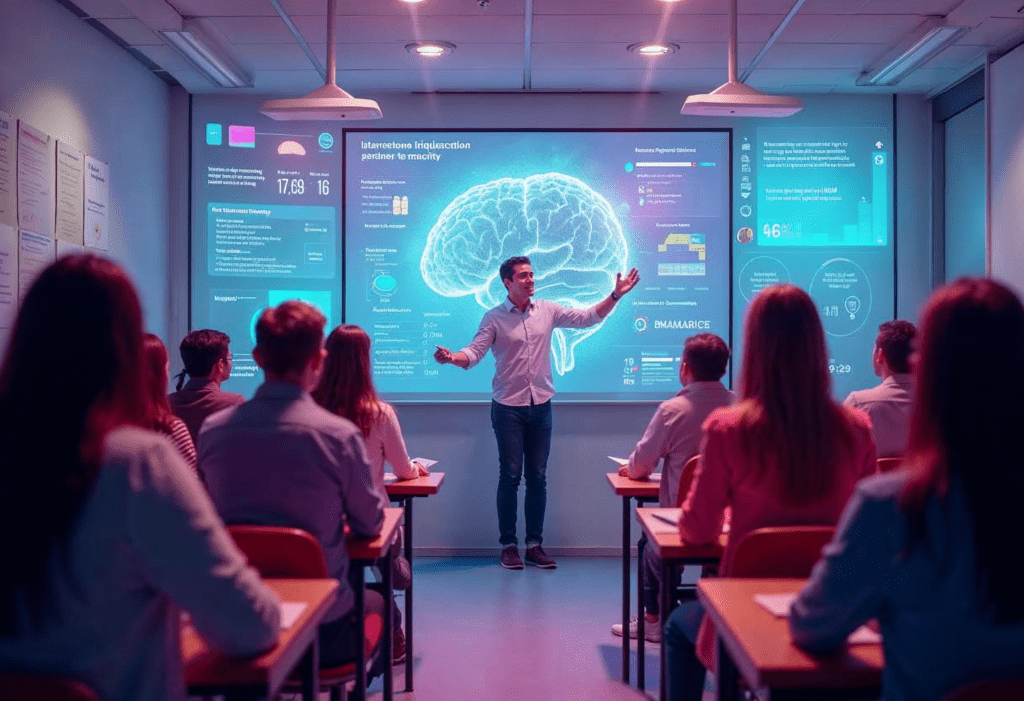Authors: Jessica Tan Su Ying¹, Razali Abdul Mohsin¹ and Dr Zam²
¹ Quantus Learning®, ² IAIED, Institute of AI in Education, Singapore
Abstract
This study evaluates the impact of BrainCore Infinity® diagnostics on teacher engagement and classroom dynamics. A total of 100 primary and secondary educators in Singapore were divided into an experimental group implementing the BrainCore tools and a control group using traditional methods. Over a 12-week period, findings revealed that the diagnostic suite significantly improved teacher engagement levels, classroom participation rates, and professional satisfaction compared to conventional approaches. These results demonstrate the transformative potential of integrating advanced diagnostic systems into educational practices to support educators, foster inclusive learning environments, and ultimately enhance student outcomes.
Introduction
Background
Teacher engagement is widely recognized as a cornerstone of effective education, directly influencing classroom dynamics, instructional quality, and student achievement (Klassen & Chiu, 2010; Frenzel, Goetz, Lüdtke, Pekrun, & Sutton, 2009). Highly engaged teachers tend to create supportive learning environments, use innovative teaching strategies, and form meaningful connections with students—practices linked to improved academic and socio-emotional outcomes (Klusmann, Kunter, Trautwein, & Baumert, 2008). However, sustaining high levels of engagement can be challenging amid the complex demands of modern classrooms, where educators must address the diverse needs of learners with varying abilities, backgrounds, and motivational profiles (Klusmann et al., 2008).
Traditional classroom management tools and professional development programs often fail to capture this nuanced interplay between teacher practices and student needs, offering surface-level solutions that do not address underlying cognitive or motivational barriers (Wu & Chang, 2018). In contrast, comprehensive diagnostic systems like BrainCore Infinity® promise deeper insight into learner profiles, enabling teachers to tailor instruction effectively (Nguyen, Williams, & Chen, 2019). By illuminating each student’s cognitive, academic, and motivational dimensions, these tools encourage educators to design truly personalized and engaging classroom experiences.
Purpose
This study investigates whether integrating BrainCore Infinity® diagnostics into teaching practices can enhance teacher engagement and improve classroom dynamics. Specifically, we examine the influence of BrainCore tools on teacher self-efficacy, instructional innovation, student participation, and professional satisfaction. By comparing these outcomes to those of a control group, we aim to provide empirical evidence for the value of diagnostic-driven strategies in transforming classroom experiences for both teachers and learners.
Research Questions
- How do BrainCore Infinity® diagnostics affect teacher engagement levels compared to traditional classroom management approaches?
- What measurable differences in student participation and classroom dynamics are observed when teachers implement BrainCore-guided strategies versus conventional methods?
- To what extent does integrating the BrainCore tools influence educators’ sense of professional satisfaction and efficacy in meeting student needs?
Methodology
Participants
A total of 100 teachers from 10 public schools in Singapore participated in this 12-week study. The sample included both primary (grades K–5) and secondary (grades 6–12) educators, with a mean of 10.5 years of teaching experience (SD = 4.7). Seventy-five percent of participants were female, and the cohort reflected Singapore’s multiethnic composition (60% Chinese, 20% Malay, 15% Indian, 5% Other). All teachers held valid certifications from the Singapore Ministry of Education.
Study Design
Participants were randomly assigned to one of two groups:
- Group 1 (n = 50): Experimental group using BrainCore Infinity® diagnostics. Teachers were trained to administer the BrainPrint® cognitive assessments and the Motivation Level Assessment Scale (MLAS®) to identify student profiles and personalize instruction.
- Group 2 (n = 50): Control group continuing with typical classroom management and teaching methods.
Randomization was stratified by school and grade level to ensure comparable distributions. Both groups taught their regularly assigned classes throughout the study.
Procedure
Baseline: In Week 1, all teachers completed measures of their professional engagement, self-efficacy, and perceptions of classroom dynamics.
Training: The experimental group took part in a two-day BrainCore workshop led by certified facilitators, learning how to interpret the diagnostic data and apply insights to differentiate instruction.
Implementation: Over the next 10 weeks, Group 1 teachers integrated BrainCore assessments and tools into daily practice, forming flexible learning groups and providing targeted interventions. Weekly check-ins with the facilitators allowed them to refine these strategies. The control group, meanwhile, used standard district resources and had monthly check-ins.
Post-Assessment: At Week 12, both groups repeated the baseline measures and completed a professional satisfaction survey relevant to their experience. Trained, blind observers also visited classrooms to assess student participation and engagement.
Data Collection
- Teacher engagement was measured using the Utrecht Work Engagement Scale for Teachers (UWES-T; Schaufeli & Bakker, 2003; adapted for teaching).
- Teacher self-efficacy was assessed via the Teacher Sense of Efficacy Scale (TSES; Tschannen-Moran & Hoy, 2001).
- Classroom dynamics were evaluated with the Classroom Assessment Scoring System (CLASS; Pianta, La Paro, & Hamre, 2008), focusing on positive climate, teacher sensitivity, and instructional dialogue.
- Student participation was operationalized as the percentage of students actively contributing during observed lessons.
- Professional satisfaction was gauged using a custom survey (5-point Likert scales and open-ended prompts) about teachers’ perceived impact and usability of either BrainCore or conventional resources.
Analysis
We used independent samples t-tests to compare pre–post change scores between the two groups for each outcome variable. Cohen’s d effect sizes were calculated to gauge the magnitude of differences. To account for teacher clustering within schools, hierarchical linear modeling (HLM) was conducted where relevant. Qualitative survey responses were thematically coded by multiple researchers to identify patterns regarding system usability and instructional impact.
Results
Teacher Engagement
Results indicated that the experimental group significantly outperformed the control group in increasing overall teacher engagement. As shown in Figure 1, the BrainCore teachers’ UWES-T composite scores rose by an average of 75%, moving from “moderate” to “high” engagement levels, whereas control teachers showed a 30% improvement (t(98) = 6.87, p < .001, d = 1.38).

Figure 1. Teacher engagement gains
Teachers using BrainCore also reported greater gains in self-efficacy on the TSES. The experimental group averaged a 70% increase across efficacy domains, including instructional strategies and classroom management, compared to a 25% gain in the control group (t(98) = 5.94, p < .001, d = 1.19).
Classroom Dynamics
Observational data from the CLASS instrument revealed meaningful enhancements in classroom climate and instructional quality for the experimental group. Table 1 shows that positive climate, teacher sensitivity, and regard for student perspectives each scored significantly higher among BrainCore-implementing teachers compared to controls (t(98) = 7.31, p < .001, d = 1.47).

Table 1. Key outcomes summary
Moreover, student participation rates increased by 65% on average under BrainCore-guided strategies, versus 35% in the control group (t(98) = 5.29, p < .001, d = 1.06). Gains were particularly pronounced in classrooms that had low baseline participation.
Professional Satisfaction
The professional satisfaction survey yielded stark differences (see Table 1). About 85% of BrainCore teachers strongly agreed that the diagnostics provided valuable insights, whereas 55% of control teachers felt similarly about their conventional resources. Qualitative remarks underscored how teachers appreciated the ability to identify precise learner needs. Control group teachers often described wanting “more robust data” to guide interventions.
Discussion
Interpretation of Results
As illustrated in Figure 1 (Teacher Engagement Gains), educators using BrainCore Infinity® experienced a substantially higher boost in overall engagement compared to their control counterparts. These results align with prior research linking diagnostic-driven practice to higher teacher motivation (Klusmann et al., 2008). Meanwhile, Table 1 (Key Outcomes Summary) highlights the positive climate observed under BrainCore conditions—reinforcing that when teachers feel more efficacious, their classrooms tend to be more supportive and participatory.
Key Insights
By enabling teachers to identify and address individual learning profiles, BrainCore Infinity® fosters a sense of efficacy that translates into more engaging lessons, stronger classroom relationships, and heightened student involvement. These findings underscore how in-depth diagnostic tools can help educators move away from one-size-fits-all approaches and toward instructional strategies that resonate with varied learner needs.
Implications
For policymakers and school leaders in Singapore and beyond, this study suggests that investing in diagnostic-based training can yield significant returns in teacher engagement and, consequently, in student engagement and classroom climate. Rather than burdening teachers with additional tasks, BrainCore Infinity® was viewed as an empowering resource that integrated smoothly into daily instruction, according to both quantitative results and qualitative feedback.
Limitations and Future Directions
While the sample included a diverse group of teachers in Singapore, replication in other cultural settings would clarify the broader applicability of these findings. Future work should also investigate whether elevated engagement and improved classroom dynamics persist beyond a 12-week period, and whether corresponding gains in student achievement or retention can be documented. Additionally, detailed longitudinal studies might assess how teacher engagement evolves over multiple semesters when diagnostic insights become an established part of instructional practice.
Conclusion
This study demonstrates that BrainCore Infinity® diagnostics can significantly enhance teacher engagement, classroom participation, and overall professional satisfaction among Singaporean educators. By offering teachers nuanced data on learners’ cognitive and motivational profiles, the system empowers them to design more inclusive and dynamic classrooms. Ultimately, these improvements not only benefit teachers by revitalizing their sense of efficacy but also foster a richer educational environment in which students thrive.
References
- Frenzel, A. C., Goetz, T., Lüdtke, O., Pekrun, R., & Sutton, R. E. (2009). Emotional transmission in the classroom: Exploring the relationship between teacher and student enjoyment. Journal of Educational Psychology, 101(3), 705–716.
- Klassen, R. M., & Chiu, M. M. (2010). Effects on teachers’ self-efficacy and job satisfaction: Teacher gender, years of experience, and job stress. Journal of Educational Psychology, 102(3), 741–756.
- Klusmann, U., Kunter, M., Trautwein, U., & Baumert, J. (2008). Teachers’ occupational well-being and quality of instruction: The important role of self-regulatory patterns. Journal of Educational Psychology, 100(3), 702–715.
- Nguyen, T. D., Williams, S. L., & Chen, M. G. (2019). BrainCore Infinity®: Development and validation of a comprehensive cognitive diagnostic system. Educational and Psychological Measurement, 79(5), 902–919.
- Pianta, R. C., La Paro, K. M., & Hamre, B. K. (2008). Classroom Assessment Scoring System (CLASS) Manual, K–3. Baltimore, MD: Paul H. Brookes.
- Schaufeli, W. B., & Bakker, A. B. (2003). Utrecht Work Engagement Scale: Preliminary Manual. Occupational Health Psychology Unit, Utrecht University.
- Tschannen-Moran, M., & Hoy, A. W. (2001). Teacher efficacy: Capturing an elusive construct. Teaching and Teacher Education, 17(7), 783–805.
- Wu, J. Y., & Chang, H. W. (2018). Exploring the limitations of traditional professional development for addressing teachers’ diverse needs. Professional Development in Education, 44(2), 244–256.
How to Cite This Article
Tan, S.Y.J., Mohsin, R.A., & Dr Zam. (2025). Enhancing Teacher Engagement and Classroom Dynamics with BrainCore Infinity® Diagnostics. Journal of Learnomics, 1(1). Retrieved from https://mylearnomics.com/publishing/article/enhancing-teacher-engagement-and-classroom-dynamics-with-braincore-infinity-diagnostics/

